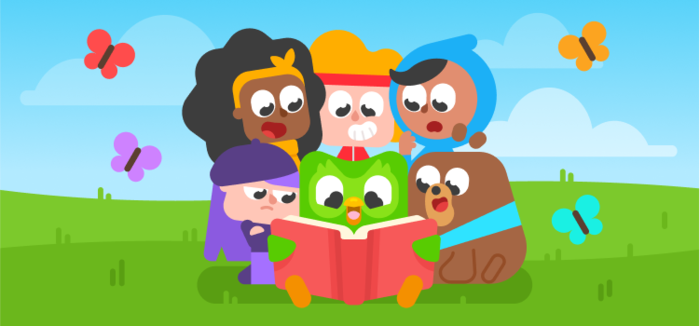This post is sponsored by Duolingo ABC
According to Reading is Fundamental – Literacy Network, 25 million children in the US are unable to read proficiently, and 65% of 4th graders read below grade level, contributing to 8,000 students dropping out of high school every day. One way to improve early literacy in the US is to support educators as they strive to meet the diverse needs of their students.
An effective way to do this is to meet students and their families where they already are: online. By implementing gamified learning that is accessible from anywhere, young readers can develop strong literacy skills in ways that are engaging.

Angela DiCostanzo (M. Ed.) is the Lead Curriculum Designer for Duolingo ABC, a free, gamified literacy app that was developed by a team of learning scientists, literacy specialists, engineers, illustrators, and parents who know that kids who read can change the world. The app was designed to make learning to read enjoyable for children ages 3-8 with fun challenges to keep kids motivated.
DiCostanzo has always been passionate about improving access to high-quality education as a means of empowerment and lasting social change. Before joining Duolingo, Angela spent 13 years teaching literacy and English as a Second Language in the US, Afghanistan, and Cambodia.
Recently we spoke with her about the benefits of Duolingo ABC:
Question: Many people know Duolingo as a second language-learning tool, but Duolingo ABC boosts early literacy for English-speaking children. Why did Duolingo decide to add this literacy resource for families?
Answer: Duolingo’s mission is to develop the best education in the world and make it universally available. We know that children need basic literacy skills to access the best education the world has to offer. Unfortunately, for many children, even basic education remains out of reach. According to UNESCO (2017), six out of ten children and adolescents were failing to achieve minimum proficiency reading levels. Our goal is for every child to learn to read. That’s why we made Duolingo ABC.
Improving access to education is just the beginning. Learning to read, like learning a second language, is not easy. At Duolingo, we make learning fun. We want kids to have fun learning to read to help them persist through the challenges, discover the joy of reading, and become lifelong readers/learners.
Q: With what standards was Duolingo ABC built? Were educators involved in the process?
A: Our curriculum is aligned with Common Core standards and based on recommendations by the seminal report of the National Reading Panel (2000) and the latest research on how kids learn to read. The National Reading Panel affirmed the effectiveness of reading instruction targeting the following components: phonemic awareness, phonics, fluency, vocabulary, and comprehension. The latest research continues to suggest that systematic, explicit phonics instruction leads to better outcomes for all children, especially those at risk of reading difficulties. That’s why phonics — knowledge of letters and the sounds they represent — is at the core of our early literacy program.
The design of Duolingo ABC draws from the latest research and from the practical experience of classroom teachers.
Q: Success in early literacy requires finding a way to capture the reader’s interest. How does Duolingo ABC drive engagement with children or keep them interested?
A: We aim to capture children’s interest and imagination with the following features:
- a world populated with delightful characters,
- positive, giggle-inducing stories, and
- bite-sized, gamified phonics lessons.
When children enter the Duolingo ABC world, they meet Duo, our green owl mascot, and FoFo, an adorable, accident-prone bear. Children progress through our lesson path by completing short phonics lessons interspersed with original stories imbued with positive messages and a heavy dose of kid-directed humor. Along the way, they encounter more of Duo’s friends, both human and animal.
Q: How does Duolingo ABC provide adequate modeling and feedback to each child and teacher?
A: Our lesson and story activities provide modeling of both how to interact with the app and how to be a great reader! Here are a couple of examples:
- Letter tracing: A short video shows children how to trace each letter. Then, children practice tracing the letter in “guardrail” mode before they try it in “freehand” mode. If they have two failed “freehand” attempts, the app goes back into “guardrail” mode.
- Narrated stories: Children are invited to repeat each sentence after listening to the sentence read aloud by a fluent reader.
One of the great things about app-based learning is the opportunity to engage learners with continuous interaction and immediate feedback if their response is correct or incorrect. This helps learners stay on the right track as they form new hypotheses and test out their latest ideas.
We currently email progress reports to the grown-ups who create accounts on Duolingo ABC. We’re working with teachers to understand what kinds of feedback would be most useful to them.
Q: Please explain additional ways that Duolingo ABC helps keep students engaged and motivated.
A: One way we keep kids engaged is by providing highly interactive experiences.
As children interact with the app, they receive a lot of positive feedback and encouragement. We use delightful sound effects, illustrations, and animation to celebrate every achievement. When kids make mistakes, we provide quick tips via voice-over and/or visual cues and encourage kids to try again and continue learning.
When kids enter the app, they are given a mission to help Duo the green owl collect books. These “books” are the stories that kids encounter along our learning path. Kids love stories, so knowing that there are more stories ahead on the path gives them a reason to keep going.
Q: Do you have any evidence that Duolingo ABC is effective at helping kids learn to read?
A: We are excited to share the evidence that kids are learning with Duolingo ABC. In 2021, Duolingo funded a research study that was done independently by the Education Development Center. EDC found that:
- Kids who utilized the Duolingo ABC app for 9 weeks showed a 28% improvement in their literacy scores, and
- Kids who used the Duolingo ABC app for 2 months showed the same improvement in early literacy skills expected from 2 months of kindergarten.
In addition, parents in the study reported that kids showed more interest in reading after using Duolingo ABC.
Q: What is your approach to gamified learning? How did you look at the 5 pillars of reading (phonics, phonemic awareness, fluency, vocabulary, and reading comprehension) and build this into a gamified curriculum?
A: Here’s what we’re aiming for: When caregivers and teachers ask kids if they want to use Duolingo ABC, kids respond with an enthusiastic “yes”. Everything from the visuals to the sound effects to the language we use is designed to make the experience feel like a game. We avoid lengthy explanations and use accessible, everyday language. Our lessons and stories are bite-sized and highly interactive. Learners are continually learning by doing rather than by listening passively or simply watching.
While we want kids to consider Duolingo ABC a game, we want teachers and parents to know that our curriculum is designed to equip kids with strong foundational reading skills.
Phonics is the centerpiece of the curriculum for early literacy learners. Each set of lessons is built around a letter-sound pair, for example, the letter “m” and the sound “mmm”. Our learning path takes kids step by step through the most frequent and consistent letter-sound correspondences in the English language, so they learn to sound out words as quickly as possible. The exercises in our earliest lessons provide additional support for building phonemic awareness, helping kids identify the individual sounds that spoken words are made of.
Because there’s more to reading than sounding out words, we surround each set of letter-sound lessons with mini-story activities so that kids see lots of fun examples of the letter-sound in meaningful, connected text. As children listen, read along, and repeat sentences, they have opportunities to experience and develop fluent reading. In addition to the phonics- and fluency-focused activities, stories include comprehension and vocabulary questions that guide children to actively engage with the meaning of the story and the less-frequent words they encounter.
If you are interested in using Duolingo ABC in your classroom to help kids learn to read, you can download it for free on the App Store or get it on Google Play.
